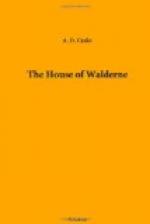The remaining child, Sybil, alone gladdened her old father’s heart and closed his eyes, weary of the world, in peace; after which she married Sir Nicholas de Harengod, and became Lady of Icklesham, by the sea, and Walderne up in the Weald.
The castle was originally one of those robber dens which were such a terror to their vicinities in the days of King Stephen; it escaped the general destruction of such holds under Henry Plantagenet, and became the abode of law-abiding folk.
It had long ceased to be a source of terror to the neighbourhood when it came into the possession of the Denes—to whom it was a convenient hunting seat; fortified, as a matter of course, by royal permission, which ran thus:
“Know that we have granted, on behalf of ourselves and our heirs, to our beloved Ralph de Dene that he may hold and keep his houses of Walderne fortified with moat and walls of stone and lime, and crenellated, without any let or hindrance from ourselves or our heirs.”
This permission was made necessary in the time of the great Plantagenet, in order to prevent the multiplication of fortified places of offence as well as defence by tyrannical barons or other oppressors of the commonwealth; for in the days of Stephen, as we have remarked already, many, if not most, of such holds had been little better than dens of robbers, as the piteous lament which concludes the “Anglo-Saxon Chronicle” too well testifies.
The space enclosed by the moat and outer walls of Walderne Castle was about 150 feet in diameter.
The old lord died in the arms of his remaining daughter Sybil, without seeking any reconciliation with his other children—in fact Roger was lost to sight—upon her head he concentrated the benediction which should have been divided amongst the three.
She married Sir Nicholas of Harengod, near the sea, and was happy in her choice. She built a chapel within the castle precincts, and her prayer for permission to do so yet remains recorded:
“That it may be allowed me to have a chapel in my castle of Walderne, at my own expense, to be served by the parish priest as chaplain; without either font or bell.”
It was granted upon the condition that to avoid any appearance of schism, she should attend the parish church in state with her whole household thrice in the year.
Six Hundred Years Ago: they have all been dead and buried these six centuries; a dense wood, within which the moat can be traced, covers the site of Sybil’s castle and chapel, yet in these old records they seem to live again. A sojourner for a brief summer holiday amidst their former haunts—the same yet so changed—the writer has striven to revivify the dry bones, and to make the family live again in the story he now presents to his readers.




